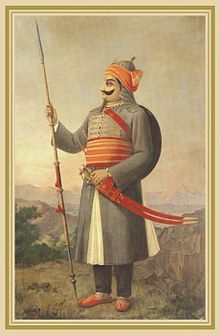This is an old revision of this page, as edited by Abecedare (talk | contribs) at 17:14, 9 February 2015 (rvt; unreliable). The present address (URL) is a permanent link to this revision, which may differ significantly from the current revision.
Revision as of 17:14, 9 February 2015 by Abecedare (talk | contribs) (rvt; unreliable)(diff) ← Previous revision | Latest revision (diff) | Newer revision → (diff)| Rajput Clan Sisodia | |
 | |
| Claim Descent From | Suryavansh |
| Descended from: | Koshal |
| Branches (Gotras): | Gahlots, Bachals, Gohils |
| Ruled in | Delhi, Agra, Uttar Pradesh, Haryana, Rajasthan, Gujarat |
| Princely states: | Ayodhya, Awadh, Koshal, Rajputana |
| Population Location: | India, Nepal and Pakistan |
| Languages: | Hindi, Rajasthani, Haryanvi, Braj Bhasa, Awadhi |

The Sisodia (also known as Sesodia, Shishodia, Shishodya, Sisodya, Sisodhya or Sisodiya) are Chattari Rajputs of the Suryavanshi lineage who ruled over the kingdom of Mewar in Rajasthan. Prior to Rana Hamir the clan was known as Gehlot or Guhilot.
Origins
Historical
The clan claims that they moved from Lahore — then known as Lohkot or Lavasthali — to Shiv Desh (Chittor) in V.S. 191. Bappa Rawal conquered Chittor, taking it from a ruler of the Mori dynasty, and established Mewar,
Sisodia lineage from Chittod which moved to Deccan
The royal Bhonsle Maratha clan, to which the Maratha Empire's founder Shivaji belonged, also claim descent from the Sisodia clan. According to this theory, Shivaji's ancestors migrated from Mewar to the Deccan. Pandit Gaga Bhatt of Varanasi presented a genealogy declaring that Shivaji's ancestors were Kshatriyas descended from the solar line of the Rajput Ranas of Mewar. Documents written in Farsi in the possession of the Ghorpade family of Mudhol claim that Bhonsle and Ghorpade are Sisodia Rajputs: these documents, which were translated in the 1930s, refer to Rana Ugrasena, father of Karna Singh and his younger brother Shubha Krishna, as common ancestors of both the Bhonsle and Ghorpade. The Ghorpade title was given to Karna Singh and his son, Bhimsen, in recognition of their capture of the fort of Khelna (presently, Vishalgad) in 1470 AD with the help of an Iguana, which is called Ghorpad in Marathi. These Farsi firmans given to ancestors of Ghorpade and Bhonsle by early Bahamani Sultans and then Adil Shahi Sultans link both the Bhonsle and Ghorpade families to Ugrasena who is considered a common ancestor by them.
See also
References
- Mountstuart Elphinstone, The history of India: the Hindú and Mahomedan periods
- The Indian historical quarterly, Volume 26, Page 268
- Rajendra Sanjay, Bappa Rawal,page 10
- Shweth George E, Bappa Rawal, Page8
- Bhawan Singh Rana (2005). Chhatrapati Shivaji. A.H.W. Sameer series. Diamond Pocket Books. p. 9. ISBN 978-81-288-0826-5.
- H. S. Sardesai (2002). Shivaji, the great Maratha, Volume 2. Genesis Publishing Pvt Ltd. p. 428. ISBN 978-81-7755-284-3.
- The Bahmanis of the Deccan - Haroon Khan Sherwani - Google Books
- Shivaji, the last great fort architect - Rameśa Desāī, Maharashtra Information Centre - Google Books
- New Indian antiquary - Google Books
| Clans of the Rajput people | |
|---|---|
| Suryavanshi | |
| Chandravanshi | |
| Agnivanshi | |
| Subclans | |
| Subdivision Clans | |